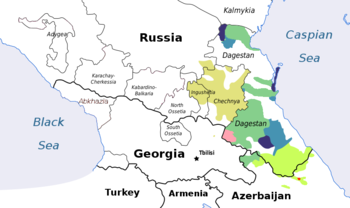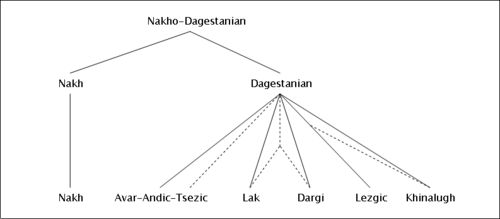- Northeast Caucasian languages
-
Northeast Caucasian Nakh(o)-Dag(h)estanian, Caspian Geographic
distribution:Caucasus Linguistic classification: North Caucasian ? - Alarodian ?
- Northeast Caucasian
Subdivisions: Avar–AndicLezgic
The Northeast Caucasian languages constitute a language family spoken in the Russian republics of Dagestan, Chechnya, Ingushetia, northern Azerbaijan, and in northeastern Georgia, as well as in diaspora populations in Russia, Turkey, and the Middle East. They are also called Nakho-Dagestanian / Nakh–Dagestanian or just Dagestanian (Daghestanian), or sometimes Caspian, as opposed to Pontic for the Northwest Caucasian languages.
Contents
Name of the family
Several names have been in use for this family. The most common term, Northeast Caucasian, contrasts the three established families of the Caucasus language area: Northeast Caucasian, Northwest Caucasian, and South Caucasian (Kartvelian). This may be shortened to East Caucasian, especially by those linguists who accept the North Caucasian languages as a language family. The older term Nakho-Dagestanian reflected an erstwhile primary division of the family into Nakh and Dagestanian branches, a view which is no longer widely accepted. The rare term Caspian (that is, bordering the Caspian Sea) is only used in opposition to Pontic (that is, bordering the Black Sea) for the Northwest Caucasian languages.
Linguistic features
Phonology
This family is known for the complex phonology (70+ consonants or up to 30 vowels in some languages). Most languages in this family contrast tense and weak consonants. Tense consonants are characterized by the intensiveness of articulation, which naturally leads to a lengthening of these consonants.
Morphology
These languages can be characterized by strong suffixal agglutination. Weak tendencies towards inflexion may be noted as well. Nouns display covert nominal classification, but partially overt cases of secondary origin can be observed too; classes in individual languages range from two up to eight. As to the grammatical number, opposition between the singular and plural (which can be classifying to some extent) and, sometimes, the collective is seen. Many languages distinguish local versus functional cases, to some degree also casus rectus versus casus obliquus. The inflexional paradigms are often based on, partially-classifying, productive stem extensions (absolutive, oblique, ergative, and genitive flexion). Localization is mostly conveyed by postpositions, but it can be also partly based on preverbs. Noun phrases exhibit incomplete class agreement, group inflexion (on the noun) with partial attributive oblique marking, which may, in turn, carry a partially determining function.
Language classification
 Traditional classification (Nichols (2003))
Traditional classification (Nichols (2003))
 Latest attempt at internal classification (Schulze (2009))
Latest attempt at internal classification (Schulze (2009))
 Branching without relative chronology (Schulze (2009))
Branching without relative chronology (Schulze (2009))
A long-time classification divided the family into Nakh and Dagestanian branches, whence the term Nakho-Dagestanian.[1] However, attempts at reconstructing the protolanguage suggest that the Nakh languages are no more divergent from Dagestanian than the various branches of Dagestanian are from each other,[2] although this is still not universally accepted. The following outline, based on the work of linguist Bernard Comrie and others, has been adopted by Ethnologue. Population data is from Ethnologue 16th ed.
Nakh family
Main article: Nakh languagesSpoken in Chechnya, Ingushetia, and Georgia. Chechen and Ingush are official languages of their respective republics.
- Batsbi (Bats) (3,420 speakers in Georgia in 2000)[3]
- Vainakh languages
Avar–Andic family
Main article: Avar–Andic languagesSpoken in the Northwest Dagestan highlands and western Dagestan. Avar is the lingua franca for these and the Tsezic languages, and the only literary language. Schulze (2009) gives the following family tree for the Avar–Andic languages:
- Avar (788,960)
- Andic languages
- Andi (Qwannab) (21,800)
- Akhvakh–Tindi
Figures retrieved from Ethnologue.[6]
Tsezic (Didoic) family
Main article: Tsezic languagesSpoken mostly in Southwest Dagestan. None are literary languages. Formerly classified geographically as East Tsezic (Hinukh, Bezta) and West Tsezic (Tsez, Khwarshi, Hunzib), these languages may actually form different subgroupings according to the latest research by Schulze (2009):
- Tsez–Hinukh
- Tsez (Dido) (15,000)
- Hinukh (Hinux, Ginukh) (200 speakers)
- Bezhta–Hunzib–Khwarshi
- Bezhta (Kapucha) (5,000)
- Hunzib (Gunzib) (2,000)
- Khwarshi (Khvarshi) (8,500)[7]
Lak isolate
Main article: Lak languageSpoken in the Central Dagestan highlands. Lak is a literary language.
- Lak (120,000 speakers)
Dargi (Dargin) dialect continuum
Main article: Dargin languagesSpoken by 370,000 in the Central Dagestan highlands. Dargwa proper is a literary language.
- Dargwa (Dargva)
- Kajtak
- Kubachi
- Itsari
- Chirag
Khinalug (Xinalug) isolate
Main article: Khinalug languageSpoken in northern Azerbaijan.
- Khinalug (Xinalug) (2000 speakers)
Lezgic family
Main article: Lezgic languagesSpoken in the Southeast Dagestan highlands and in Northern Azerbaijan. The Lezgian language or, as the Lezgins themselves call it, Лезги чlал (lezgi ch'al), is the biggest, in terms of the number of native speakers, of all the languages of the Lezgic group (other languages from this group include Tabasaran, Udi, Tsakhur, and Rutul – Tabasaran was once thought to be the language with the largest number of grammatical cases at 54, which could, depending on the analysis, instead be the Tsez language with 64). The Lezgic family along with a couple of other families (Avar–Andic, Tsezic, Lak, Dargin, and Khinalug) forms the Daghestanian part of the Nakh–Daghestanian language family (the Nakh part is constituted by Chechen, Ingush and related small languages).
Lezgian and Tabasaran are literary languages.
Lezgic family tree
- Peripheral: Archi (1200 speakers)
- Samur (or Nuclear Lezgian)
Connections to other families
North Caucasian family
Many linguists[who?][citation needed] think that the Northeast and Northwest Caucasian languages should be joined into a putative North Caucasian family, sometimes called Caucasic or Caucasian (even though it is not meant to include the South Caucasian (Kartvelian) family). However, this hypothesis is not well demonstrated.
Connections to Hurrian and Urartian
Some linguists — notably I. M. Diakonoff and S. Starostin — also see similarities between the Northeast Caucasian family and the extinct languages Hurrian and Urartian. Hurrian was spoken in various parts of the Fertile Crescent in the 3rd and 2nd millennia BC. Urartian was the language of Urartu, a powerful state centered in the area of Lake Van in Turkey, that existed between 1000 BC or earlier and 585 BC.
The two extinct languages have been grouped into the Hurro-Urartian family. Diakonoff proposed the name Alarodian for the union of Hurro-Urartian and Northeast Caucasian.
Agricultural vocabulary
The Proto-Northeast Caucasian language had many terms for agriculture, and Johanna Nichols has suggested that its speakers may have been involved in the development of agriculture in the Fertile Crescent.[9] They had words for concepts such as yoke, as well as fruit trees such as apple and pear that suggest agriculture was already well developed when the proto-language broke up.
Footnotes
- ^ See Nichols (2003)
- ^ See Schulze (2009)
- ^ Ethnologue report for Bats
- ^ Ethnologue report for Chechen
- ^ Ethnologue report for Ingush
- ^ http://www.ethnologue.com
- ^ Khalilova (2009), p. 3
- ^ Ethnologue report for Tabasaran
- ^ See Wuethrich 2000
See also
- Languages of the Caucasus
- Swadesh list of Avar–Andic languages
- Swadesh list of Lezgic languages
References
- Khalilova, Z. (2009). A grammar of Khwarshi.
- NICHOLS, Johanna (2003), "The Nakh-Daghestanian consonant correspondences", in TUITE, Kevin; HOLISKY, Dee Ann, Current trends in Caucasian, East European, and Inner Asian linguistics: Papers in honor of Howard I. Aronson, Amsterdam: Benjamins, pp. 207–251, ISBN 9781588114617, http://books.google.cz/books?id=REPC96ddSc0C&pg=PA207&dq=Current+Trends+in+Caucasian,+Inner+Asian+Nakh-Daghestanian
- SCHULZE, Wolfgang (January 31, 2009), "The Languages of the Caucasus" (PDF), http://wolfgangschulze.in-devir.com/index.php?option=com_docman&task=doc_download&gid=63
- SCHULZE, Wolfgang (2007), "Personalität in den ostkaukasischen Sprachen" (PDF), Munich Working Papers in Cognitive Typology, IATS University of Munich, http://www.lrz-muenchen.de/~wschulze/mwpct4.pdf
- SCHULZE, Wolfgang (2001), "Die kaukasischen Sprachen", in M. Haspelmath et al., La typologie des langues et les universaux linguistiques, 2, Berlin/New York: Mouton de Gruyter, pp. 1774–1796
- WUETHRICH, Bernice (19 May 2000), "Peering Into the Past, With Words", Science 288 (5469): 1158, doi:10.1126/science.288.5469.1158, http://www.sciencemag.org/cgi/content/full/288/5469/1158.
External links
- Various Northeast Caucasian language dictionaries online from IDS (select simple or advanced browsing)
- A nice map depicting all the languages in the Caucasus: http://www.hunmagyar.org/turan/caucasus/index.html
- CIA linguistic map of the Caucasus
- MultiTree Page for Northeast Caucasian languages
- Ethnologue: North Caucasian, Northeast
Categories:- Northeast Caucasian languages
- Agglutinative languages
- Languages of Russia
- Language families
- Alarodian ?
Wikimedia Foundation. 2010.
